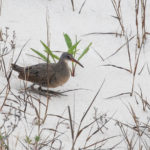Ophryocystis elektroscirrha (O.e.) Infection in Monarchs Migrating through Cape May Point, NJ
By Gayle Steffy, 2024 MMP Field Naturalist
Ophryocystis elektroscirrha. (O.e.) is a parasitic single celled organism known as a protozoan that infects monarch butterflies. It is transferred from an infected adult monarch to a caterpillar by spores that cover the body of the infected butterfly. These spores drop off as the infected butterfly moves about. If these spores land on milkweed plants, as often happens when an infected butterfly lays eggs, the spores are eaten by the caterpillar. Inside the caterpillar’s gut, the spores break open and release the parasites, which reproduce and multiply as the caterpillar grows. When the caterpillar enters the chrysalis stage, the parasites move to the outside of the body and form spores, ready to infect the next generation and continue the cycle.
This fall, 225 monarchs were tested for the presence of O.e. before being tagged and released. O.e. testing was performed by aseptically pressing a circle of transparent tape to the abdomen of the monarch to lift a sample of scales, then adhering the tape on an index card. These samples were later examined under a microscope for the presence of O.e. spores.



O.e samples (left). Microscopic analysis shows a healthy monarch (center) and a heavily infected one (right).
The graph below shows the results of the O.e. testing. 45 monarchs were tested in each sample group. Only one group of monarchs was tested during September due to a lack of butterflies migrating through Cape May during the last 3 weeks of the month. Typically, <10 percent of monarchs migrating through the eastern US are infected with O.e. Therefore, the results from Cape May Point in 2024, are concerning, particularly the nearly 50% rate for October 2-3.

The toll O.e. takes on an individual monarch depends on the level of infection. An extremely infected monarch will have so many spores on its abdomen that it becomes stuck to the inside of the chrysalis and dies, or is too weak to hang onto the chrysalis until it wings are hardened and drops to the ground, resulting in crumpled wings. Many are too weak to fly and don’t survive long.
A monarch with a milder infection, including the heavily infected ones tested in Cape May Point, can look and act completely normal. However, these butterflies are often smaller and weaker than non-infected monarchs and are less likely to make it to Mexico. This is nature’s way of keeping infection rates low, as heavily infected individuals generally don’t survive the trip to Mexico or make it through the winter to pass on the infection.
The cause of the high O.e prevalence this year is unknown, but possible contributing factors include infected monarchs migrating north from Florida in the spring, lack of rain to wash spores off of milkweed leaves, and spread of infection through captive rearing. Sampling in subsequent years can determine whether these high levels of O.e. are an anomaly or a trend.
High levels of O.e. are only one of many threats to migrating monarchs, the most serious including habitat loss, climate change, pesticides and car strikes.











